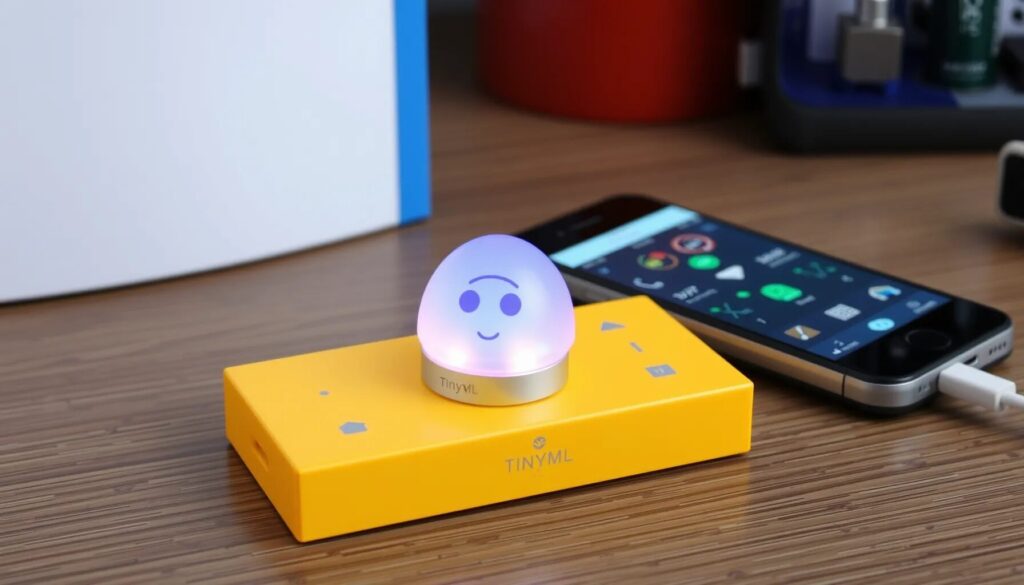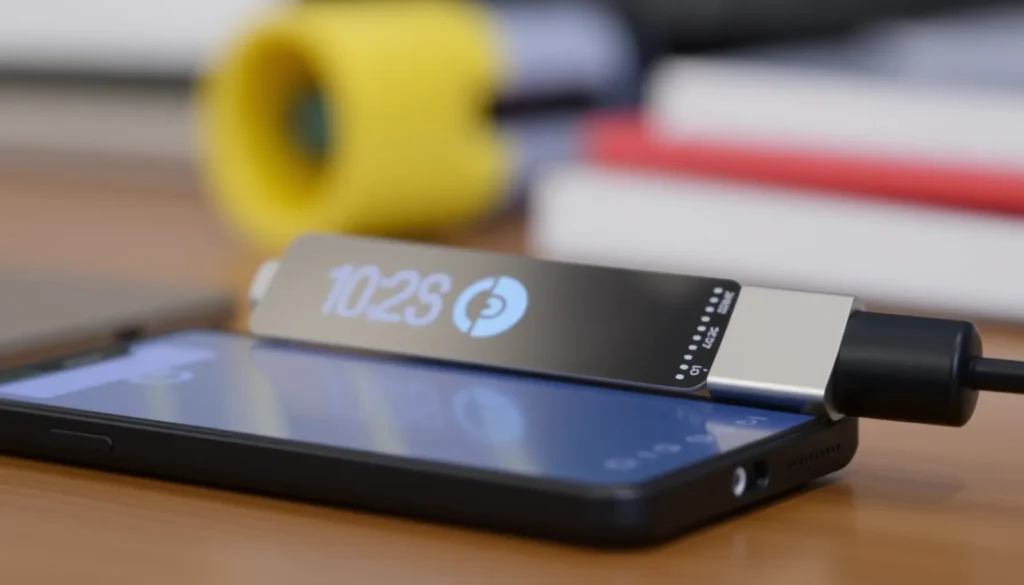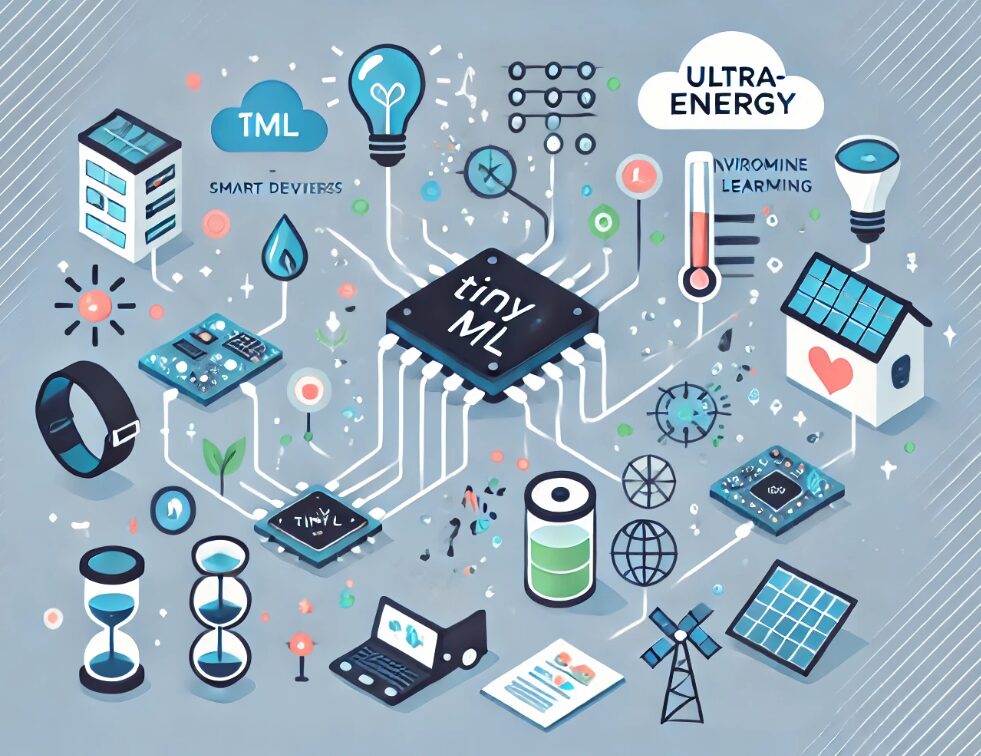
TinyML: The Future of Ultra-Low Power Edge AI for Small Devices
Tiny machine learning, or TinyML, focuses on running machine learning algorithms directly on small, ultra-low power devices, bringing the magic of artificial intelligence to edge devices like sensors, wearables, and microcontrollers. Imagine a world where even your smallest gadgets can process data in real-time without needing to connect to the cloud.
But how does this technology fit into our lives? How is it shaping the future of AI? Let’s dive deeper and explore how TinyML is revolutionizing the edge.
What is TinyML?
At its core, TinyML is about deploying machine learning models on devices with extremely limited resources. We’re talking microcontrollers with as little as 1MB of memory and minimal processing power. Yet, with advancements in hardware and software, these tiny devices are becoming capable of impressive feats. They can analyze data, make predictions, and even run sophisticated AI models—all with minimal energy consumption.
Why TinyML Matters
In a time where data privacy and energy efficiency are growing concerns, TinyML offers a solution. Processing data locally on the device means there’s no need to constantly send information to the cloud, significantly reducing latency and bandwidth usage. This edge processing capability is especially useful in remote locations or situations where connectivity is limited.
Moreover, by running models on low-power devices, TinyML drastically lowers the energy required to operate. This is a game-changer for devices that rely on batteries or solar power, extending their life and functionality.
Applications in Wearable Technology

TinyML is quickly becoming a cornerstone in wearable technology. From smartwatches to fitness trackers, these devices are packed with sensors that can monitor everything from heart rates to oxygen levels. TinyML allows these devices to not just collect data but also make sense of it in real-time, providing immediate insights.
Imagine a fitness band that can predict fatigue during a workout or detect anomalies in your heartbeat without ever needing to sync with a cloud server. It’s no longer just passive data collection—it’s real-time intelligence at your wrist.
Smarter Homes, Smarter Lives
Another exciting application of TinyML lies in smart home devices. Devices like motion sensors, thermostats, and doorbell cameras typically rely on cloud services for processing. But TinyML is changing that dynamic by enabling these devices to process information right at the edge.
For instance, your security camera could differentiate between a stray cat and an intruder without sending footage to an external server. Not only does this save energy, but it also enhances privacy, as fewer data points are exposed to potential cyber threats.
The Power of Localized Data Processing
Edge AI is about bringing computation closer to where the data is generated, and TinyML is an important part of that shift. By embedding intelligence directly into small devices, you cut out the middleman—there’s no need for every piece of data to travel to a server and back.
The implications for industries like healthcare, agriculture, and even disaster relief are enormous. Devices equipped with TinyML can operate autonomously in environments where traditional networks can’t reach. Whether it’s a medical sensor analyzing patient vitals in rural areas or a drone using TinyML to monitor crops, this technology is redefining what’s possible in real-time data processing.
Environmental Monitoring with TinyML
TinyML is making an enormous impact in environmental monitoring, an area where low-power, remote operation is critical. Think of devices scattered across forests, oceans, or even glaciers, continuously collecting data on air quality, water temperature, or animal activity. Traditionally, this data had to be transmitted to a central server for analysis. But with TinyML, these sensors can process the data locally, making decisions in real-time.
For instance, a TinyML-powered sensor in a forest could detect unusual patterns of temperature rise, indicating a potential fire, and send alerts immediately—without needing a constant internet connection. This ability to process and act on data locally is crucial, especially in remote or off-grid locations where access to power and the internet is limited. Plus, it allows for faster reaction times, which is vital in environmental emergencies.
Enhancing Security Systems
When it comes to security systems, speed and efficiency are everything. Traditional systems often rely on sending footage or data to the cloud for analysis, which can create delays and introduce privacy risks. With TinyML, security devices can run AI models directly on the hardware, making decisions in real time.
For example, a smart doorbell could use TinyML to differentiate between a family member, a delivery person, or an unknown visitor, and act accordingly. The system could alert homeowners to potential threats or ignore harmless situations, all without needing to upload sensitive footage to the cloud. This localized processing not only boosts response time but also adds an extra layer of data privacy.
Revolutionizing Healthcare
In the healthcare space, TinyML is playing a transformative role, particularly in wearable medical devices. Devices that monitor patient vitals can now make intelligent decisions on the fly. Whether it’s a smart insulin pump or a wearable heart monitor, these devices can process data locally and only send out alerts when necessary, ensuring constant monitoring while saving power and bandwidth.
Imagine a TinyML-based implant that could predict a seizure or monitor blood sugar levels without needing frequent uploads to the cloud. This localized intelligence means patients can receive real-time feedback, potentially avoiding dangerous health situations. Moreover, in resource-limited settings where access to large-scale cloud computing is not feasible, TinyML-enabled devices can function autonomously, bringing AI-driven healthcare to underserved populations.
Industrial Applications and Predictive Maintenance
Predictive maintenance is another area where TinyML is proving invaluable. In industries where machines and equipment are vital to operations, unexpected breakdowns can be costly. With TinyML embedded in sensors, machines can monitor their own performance in real-time. These sensors can detect anomalies—vibrations, temperature changes, or unusual sounds—and predict when maintenance is required.
In manufacturing plants, for instance, a TinyML-powered sensor might detect a slight change in vibration in a motor, suggesting it’s on the verge of failure. By alerting maintenance teams before a full breakdown occurs, TinyML can save time, money, and resources, all while reducing downtime.
Agriculture: Smarter Farming with TinyML
In agriculture, TinyML is helping farmers make smarter decisions with real-time data. From monitoring soil moisture to predicting pest infestations, TinyML-enabled devices offer farmers insights that would otherwise require expensive cloud processing.
TinyML-powered drones and sensors can survey large areas of farmland, making calculations on the spot, determining where more water or fertilizers are needed. This not only improves crop yields but also reduces waste. With edge AI processing right there in the field, farmers are better equipped to manage resources efficiently.
Privacy-Preserving AI
One of the most compelling benefits of TinyML is its ability to enhance data privacy. In an age where we’re constantly worried about who has access to our data, TinyML offers a solution: it processes data locally, at the edge, without needing to send sensitive information to the cloud. This keeps personal data like health metrics or security footage safe from prying eyes, reducing the chances of a data breach or misuse.
For example, a TinyML-based camera in a smart home could analyze footage locally, deciding which data is important enough to save and which can be discarded. Only the most critical information gets transmitted, drastically reducing potential privacy risks.
TinyML and Energy Efficiency

The brilliance of TinyML lies in its ability to perform complex calculations on devices that use very little power. This is particularly important in a world where energy efficiency is a top priority. Devices running on TinyML require minimal energy, meaning they can run on small batteries or solar power for extended periods.
This is ideal for remote devices like wildlife monitoring cameras or environmental sensors, which might need to run for months—or even years—without human intervention.
TinyML in Disaster Management
Another promising use case for TinyML is in disaster management. Devices can be deployed in disaster-prone areas to monitor environmental conditions and provide real-time data about potential hazards. For example, TinyML sensors could detect earthquake tremors, flood conditions, or even changes in the atmosphere that signal an impending storm. With local data processing, these devices can issue alerts faster than cloud-based systems, potentially saving lives in critical situations.
The Future of Ultra-Low Power Edge AI
The possibilities for TinyML are virtually limitless. As more industries begin to embrace this technology, we’ll continue to see exciting innovations. The idea of bringing AI to the edge—where data is created—opens doors for smarter, more efficient devices that can work independently from the cloud, saving energy, reducing latency, and protecting privacy.
From healthcare to agriculture, TinyML is already changing the game, and its potential is only just beginning. Whether it’s keeping us safe, enhancing privacy, or helping our planet, TinyML is undeniably the future of ultra-low-power AI, and its impact will be felt in ways we can only start to imagine.
TinyML: Frequently Asked Questions (FAQ)
If you’re new to TinyML or just curious about how it works, here are some commonly asked questions to help you understand this emerging technology.
What is TinyML?
TinyML refers to machine learning techniques and models specifically designed to run on small, resource-constrained devices like microcontrollers. These devices typically have limited processing power, memory, and energy, yet they can still perform powerful tasks like data analysis and decision-making directly on the device.
How does TinyML differ from traditional machine learning?
The main difference lies in the hardware. Traditional machine learning often requires powerful computers or cloud servers to run models because they need more memory and computational power. TinyML, on the other hand, runs on edge devices with far fewer resources, using highly optimized algorithms that can operate on ultra-low power hardware, often with less than 1MB of memory.
What devices can use TinyML?
TinyML can be implemented on a wide range of microcontrollers and small embedded systems. Some examples include:
- Wearables like fitness trackers and smartwatches
- IoT sensors used in smart homes or factories
- Healthcare devices for monitoring vitals
- Environmental sensors in agriculture or conservation efforts
What are the benefits of TinyML?
- Low Power Consumption: TinyML models use minimal energy, which is ideal for battery-powered devices or those that rely on solar energy.
- Real-time Processing: Since the data is processed directly on the device (at the edge), there’s no need to wait for cloud processing, reducing latency.
- Improved Privacy: Data doesn’t need to be sent to the cloud for processing, minimizing privacy risks.
- Cost-Efficiency: Devices equipped with TinyML can be produced at lower costs, making them suitable for large-scale deployments.
What are some real-world applications of TinyML?
- Smart Home Devices: TinyML can power smart doorbells or thermostats, enabling them to analyze sensor data locally and make real-time decisions.
- Healthcare Monitoring: Wearables using TinyML can monitor health data like heart rate or blood glucose levels and offer instant feedback without needing cloud access.
- Environmental Monitoring: TinyML sensors in agriculture can track soil conditions, predict weather changes, or monitor livestock health autonomously.
- Security Systems: TinyML can be integrated into security cameras to analyze footage locally, allowing for faster threat detection and response.
Is TinyML difficult to implement?
While TinyML does require some understanding of machine learning and embedded systems, it’s becoming more accessible with the rise of open-source tools and frameworks like TensorFlow Lite for Microcontrollers and Edge Impulse. Developers can now leverage these platforms to deploy pre-trained models on small devices with minimal coding.
What programming languages are used for TinyML?
TinyML models are often implemented in Python (for training models) and C/C++ (for deployment on microcontrollers). Popular frameworks like TensorFlow Lite or Arduino libraries offer tools to simplify the deployment process for these models.
Can TinyML work without an internet connection?
Yes! That’s one of the biggest advantages of TinyML. Since all processing happens on the device itself, there’s no need for continuous connectivity to the internet. This makes TinyML ideal for remote locations or mission-critical applications where reliable internet access may not be available.
What are the challenges of TinyML?
Some challenges include:
- Limited Processing Power: Devices that run TinyML typically have limited computational power, so models must be highly optimized.
- Memory Constraints: TinyML models must fit into tiny memory spaces, often less than 1MB, making model compression techniques important.
- Energy Limitations: TinyML models need to be extremely power-efficient, especially for devices that rely on batteries or alternative energy sources like solar power.
How do I get started with TinyML?
To get started, you can explore some popular TinyML development platforms and tools:
- TensorFlow Lite for Microcontrollers: A widely used framework to run machine learning models on edge devices.
- Arduino IDE: If you’re working with Arduino hardware, there are machine learning libraries available to help you deploy TinyML models.
- Edge Impulse: This platform simplifies the process of building and deploying TinyML models on embedded devices.
For beginners, there are many online courses, like Coursera’s “Introduction to Embedded Machine Learning”, or Harvard’s TinyML professional certificate on edX.
How small are the models used in TinyML?
TinyML models are designed to be incredibly compact. In many cases, they are compressed or optimized to fit within 1MB or less of memory. This requires advanced techniques like quantization to shrink the model size without sacrificing too much accuracy.
Is TinyML the same as Edge AI?
TinyML is a subset of Edge AI. While both refer to processing data locally, TinyML specifically focuses on running machine learning models on very low-power, resource-constrained devices, like microcontrollers. Edge AI, on the other hand, may also include slightly larger devices, such as gateways or edge servers, with more processing power and energy consumption.
This FAQ provides a basic overview of TinyML. As the technology continues to evolve, expect more resources, tools, and real-world applications to emerge, further pushing the boundaries of ultra-low power AI on edge devices.
Resources for Learning More About TinyML
If you’re excited about TinyML and want to dive deeper into the technology, there are a wealth of resources available. Whether you’re a beginner or someone with experience in machine learning, these resources will help you explore and understand how TinyML is shaping the future of edge AI.
Books
- “TinyML: Machine Learning with TensorFlow Lite on Arduino and Ultra-Low-Power Microcontrollers” by Pete Warden and Daniel Situnayake
This is one of the most comprehensive books for beginners and professionals alike. It covers the basics of deploying machine learning on small devices, with practical examples using TensorFlow Lite and Arduino. - “Real-Time Machine Learning on Embedded Systems” by Ian Lowe
This book dives into the practical aspects of TinyML, focusing on real-time processing and use cases for embedded systems. It’s perfect for developers looking to integrate TinyML into their projects.
Online Courses
- Coursera: “Introduction to Embedded Machine Learning”
This course, offered by Edge Impulse, introduces the basics of TinyML, including building machine learning models for embedded devices. A great starting point for anyone new to AI on small devices. - Harvard’s “Tiny Machine Learning (TinyML)” Professional Certificate
Harvard offers an extensive TinyML professional certificate program on edX. It’s designed to give a deep understanding of building and deploying machine learning models on microcontrollers.
Frameworks and Tools
- TensorFlow Lite for Microcontrollers
TensorFlow Lite is one of the most popular frameworks for deploying machine learning models on edge devices. It’s optimized for low-power hardware and widely supported in the TinyML community. You can find tutorials, documentation, and code samples on their official website. - Edge Impulse
A platform that makes it easy to build, deploy, and test machine learning models on embedded devices. Edge Impulse supports a wide variety of TinyML applications, from audio and vision models to sensor fusion.
Communities and Forums
- TinyML Community
The TinyML Foundation offers a global community for developers, researchers, and enthusiasts. You can attend webinars, join discussions, and stay updated with the latest in TinyML through their official site. - Arduino Forum
If you’re using Arduino to build TinyML projects, the Arduino community forums offer a wealth of advice, tutorials, and troubleshooting help. It’s an excellent space for beginners and experts alike.
Academic Papers
- “TinyML: Enabling Machine Learning on IoT Devices at the Edge” by Vijay Janapa Reddi, et al.
This paper provides an academic introduction to TinyML, outlining its challenges, opportunities, and potential. You can find it in IEEE’s publication archives. - “Machine Learning at the Network Edge: A Survey”
This paper covers the broader edge AI landscape, including TinyML, and discusses how machine learning is transforming the IoT and edge computing ecosystems.
Conferences
- TinyML Summit
The TinyML Summit is an annual conference where researchers, developers, and companies come together to share the latest innovations and trends in TinyML. You can catch up on previous presentations or register for upcoming events on their website.
Open Source Projects
- TinyML-Kit
A collection of open-source projects focused on implementing TinyML applications on microcontrollers. You’ll find resources for voice recognition, gesture detection, and more on GitHub. - Arduino’s Machine Learning Libraries
Arduino offers a number of machine learning libraries optimized for TinyML applications. These are open-source and well-documented, making them easy to integrate into your projects.